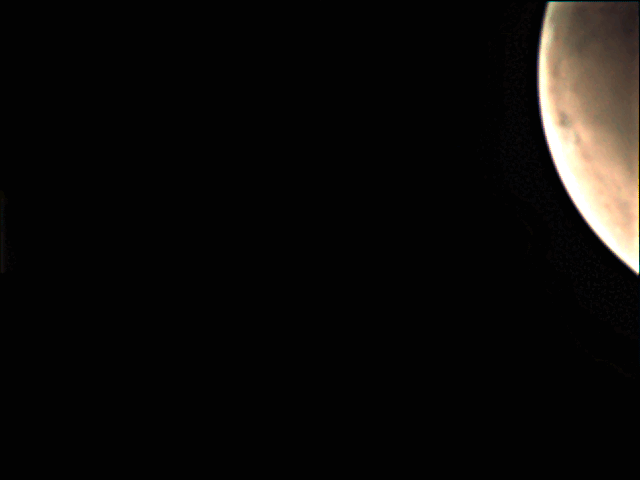To celebrate the 20th birthday of ESA’s Mars Express on 2 June, and after months of work from engineers and scientists to make it possible, ESA aired the first-ever Mars livestream. For an hour, it became possible to see the Red Planet in as close to real-time as the speed of light would allow.
This gif is made up of all the images that came down during that hour, roughly 50 seconds apart from each other, beamed directly from the Visual Monitoring Camera (VMC) on board ESA’s long-lived but-still-highly-productive martian orbiter. Note the gap in the middle – unfortunately*, rain at ESA's ground station in Cebreros, Spain, meant we lost 'telemetry' (data) from Mars Express for a period during the live.
Just before the connection is lost and there’s a break in images, a small white feature flashes up on Mars’ edge. This is not actually on the planet but a ‘stain’ in part of the sensor that increases the amount of light that reaches pixels in this area. Usually, image processing removes such noise and stains but it’s not always possible.
However, there are many fascinating martian features that reveal themselves.
"Mars is now approaching the southern winter season," explains Jorge Hernández Bernal, part of the VMC team.
“The South Polar cap is apparent in these images, close to the polar night, while the Arsia Mons volcano is present on the left side of the planet. Orographic clouds are also common during this season, and form as the atmosphere flows up mountains and volcanic slopes.”
“At the right side of the images, a different cloud is present close to the polar cap. With the VMC we have studied these high-altitude clouds in detail during twilight and revealed that they are common during this season in this part of the planet.”
What started as an engineering camera, with a single purpose of monitoring the deployment of the Beagle 2 lander, has become a science instrument that’s given us views of Mars that would otherwise be impossible, and now even live.
Making this happen was no easy feat. To get a one-hour live view of Mars, the spacecraft's VMC needed a view of the planet at the same time that MEX’s antenna could continuously face Earth to immediately stream the data home. Normally, observations are stored onboard the spacecraft and 'downlinked' to Earth in a batch once Mars Express gets visibility on a ground station.
"Usually, it’s not possible to point the spacecraft’s instruments at Mars and the communications antenna at the Earth at the same time,” says James Godfrey, Spacecraft Operations Manager for Mars Express.
“But some weeks ago, when we were looking for ideas on how to celebrate the anniversary, we realised that Mars would pass through the field of view of VMC during a communications pass and the idea was born.”
Mars Express continues in its orbit around Mars and the Visual Monitoring Camera, nicknamed the 'Mars webcam', is still beaming down images just like this. Check out its Twitter feed for an archive of Mars images, but for new images find the Mars webcam on Flickr and Mastodon.
*Rainfall was unfortunate for the livestream, but very fortunate for Spain since parts of the country are experiencing prolonged drought. While ESA monitors the weather on Mars, it is also flying many Earth observing satellites that take the pulse of our planet and provide data during emergency weather crises.



 Image:
First Mars livestream: the movie
Image:
First Mars livestream: the movie